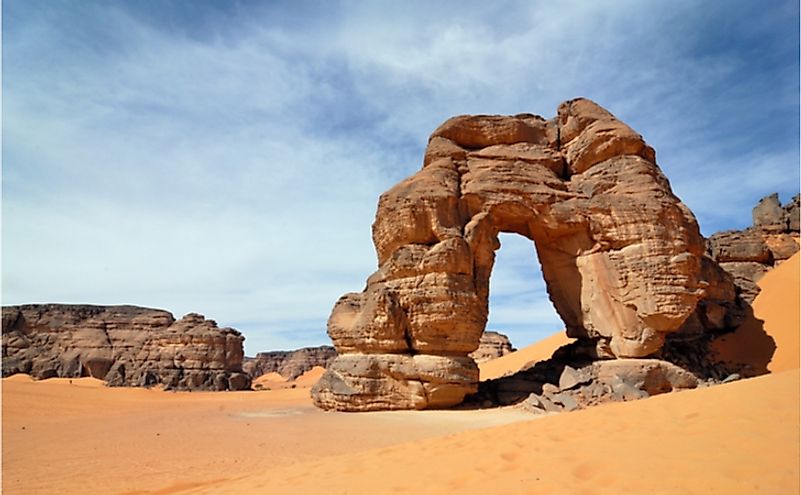10 Interesting Facts About Libya

Libya is a predominantly Islamic nation located in northern Africa. It is surrounded by six countries namely Tunisia, Algeria, Sudan, Chad, Egypt, and Niger. The state’s capital, as well as the largest city, is Tripoli. Libya has a population of approximately 7.2 million. Acclaimed as the 4th largest country in Africa by land area, Libya possesses many unique features as outlined below;
1. Libya has had only one king in its lifetime
The first and last monarch of Libya was known as King Idris I. He was both a political and religious leader who was born into the order of Senussi. King Idris I served as the Emir of Cyrenaica before his becoming the King of Libya in 1951 at the end of colonial rule. The king’s rule was unpopular because of his conservativism. In 1969, King Idris I was deposed in a coup d’état led by Colonel Gaddafi who later succeeded him.
2. Home to the largest proven oil reserves in Africa
The discovery of oil in Libya in the 1950s was a great turnaround for the country which had previously been ranked among the poorest in the world. As of 2010, the country’s annual oil production was 1.65 million barrels per day. Today, oil and petroleum products for the largest portion of the country’s exports and government revenue. Besides, it is among the 15 most thriving economies in Africa alongside South Africa, Nigeria, Algeria, Egypt, and Cameroon among others. Nonetheless, the unstable political environment of the country in the recent past led to fluctuations in its oil price globally.
3. Although popularly known as a Muslim nation, Libya possesses a rich Christian history
Today, Christianity is a minority religion in Libya. However, the country possesses strong Christian roots. Examples of two important biblical characters linked to Libya are Simon the Cyrene and St. Mark. Simon who was forced to help Jesus Christ carry his cross was from Cyrene City. Cyrene was a Libyan town that existed hundreds of years ago. On the other hand, St. Mark who wrote the gospel of Mark founded the Church of Alexandria in Egypt in 49 AD. This church birthed many of the Eastern Orthodox churches, Coptic Church, and Greek Orthodox Church which exist in Libya.
4. Historically, Libya was divided into only 3 regions namely Fezzan, Tripolitania, and Cyrenaica
Fezzan was the southwestern part of Libya, Cyrenaica occupied the eastern half of the country, and Tripolitania covered the northwestern parts of Libya. Today, the country is divided into three administrative regions that have been sub-divided into 22 districts (called shabiyat).
5. The Libyan Desert is known for going for decades without rain
The Libyan Desert comprises the eastern and northern parts of the Sahara Desert. Ideally, it is the part of the Sahara Desert found in the state of Libya. The Libyan Desert is known for being the harshest, driest, and most remote region of the Sahara. With day temperatures of up to 50 degrees Celsius, this region may go for decades without rain.
6. Libya imports 75 to 80% of its food
Libya imports most of the food consumed by its people due to its inability to locally produce the same. The country is located within the extensive Sahara desert which means it receives very low precipitation. It also possesses poor soil and climate which are both limitations to food production. A major attempt made by former Libyan President Gaddafi to reverse the situation was the financing of the Great Manmade River Project that was built for irrigation of the farming lands. This project turned out to be the world’s largest irrigation project. It comprises of 1750 miles of an underground network of water pipes. Nonetheless, Libya still depends on imported food for the survival of its people.
7. Libyan Tea is as thick as black syrup
Mostly prepared by women, the Libyan tea is very thick as a result of mixing a lot of tea leaves and a high sugar concentration. Once the two ingredients are mixed and an appropriate amount of water is added, the tea boils for 20 to 30 minutes. When the tea is ready, it is served in small pyrex glasses accompanied by sumak and khobza which are Libyan favorite bites.
8. The highest mountain in Libya is Bette Peak
Bette Peak is the highest mountain in Libya being 7,434 feet tall. Also known as Bikku Bitti, the mountain is found in southern Libya at the Chad-Libyan border. The first documented climb of the Bette Peak was by Ginge Fullen alongside his Chadian guides in December 2005. Nonetheless, the mountain’s location makes access to it difficult and rare.
9. Libya’s city of Cyrene was part of the ancient Greek empire
Cyrene, present-day Shahhat, is a city in Libya that was part of the Greek empire that existed hundreds of years ago. It was one of the most important Greek cities as it was the center of philosophy education. As one of the oldest towns in the country, Cyrene is listed among the UNESCO World Heritage Sites.
10. Muammar Gaddafi was Libya’s longest-serving leader
Muammar Gaddafi seized power in 1969 and ruled Libya for 42 years. As a result, he became one of the longest-serving African and world national heads of state. Gaddafi was famously known for being a dictatorial leader. However, he also served his country well by improving its health services to the level of being among the best in Africa. He also increased Libya’s rate of literacy from only 25% before his reign to 87%. His reign ended in 2011 when he was toppled from the government. The militia tracked him down in his hometown where he had sought refuge and assassinated him. At the time of Gaddafi’s death, his net worth was US$ 200 billion.











